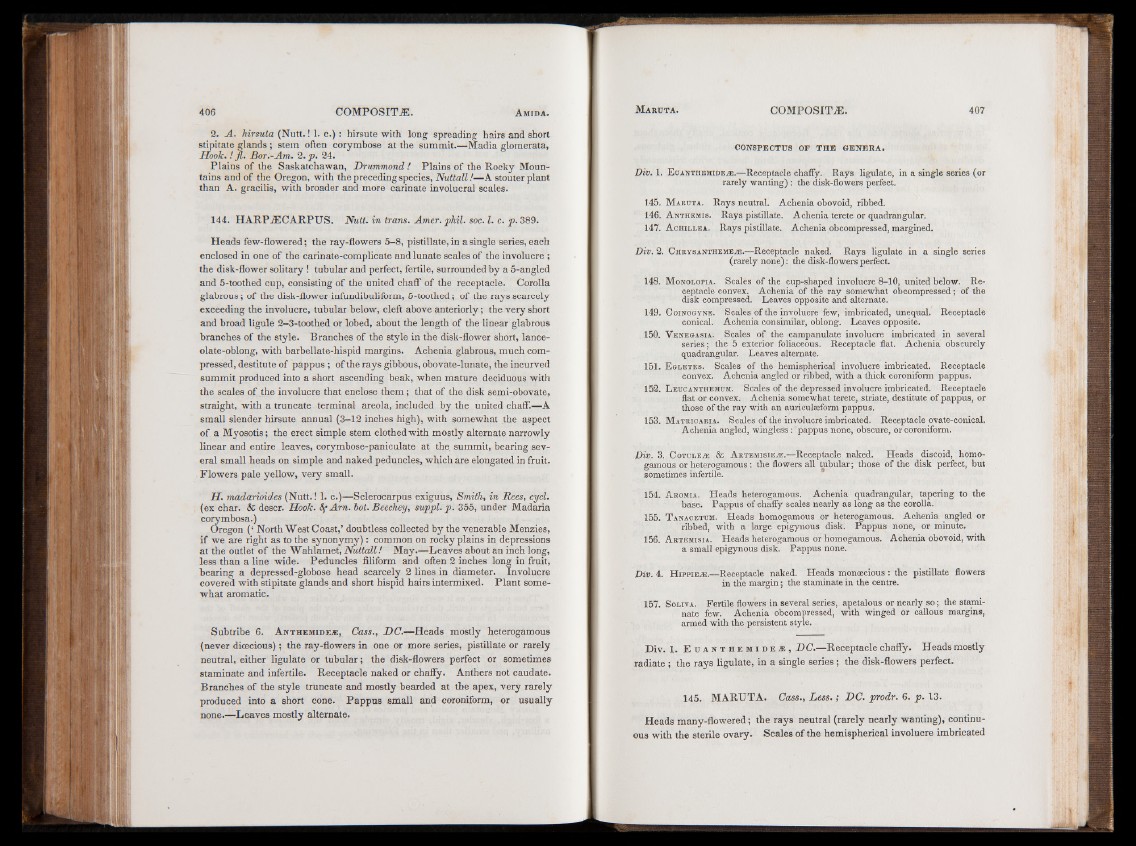
2. A. hirsuta (Nutt.! 1. c.) : hirsute with long spreading hairs and short
stipitate glands; stem often corymbose at the summit.—Madia glomerata,
Hook. ! fl. Bor.-Am. 2. p. 24.
Plains of the Saskatchawan, Drummond ! Plains of the Rocky Mountains
and of the Oregon, with the preceding species, Nuttall!—A stouter plant
than A. gracilis, with broader and more carinate involucral scales.
144. HARPiECARPUS. Nutt, in trans. Amer. phil. soc. 1. c. p. 389.
Heads few-flowered; the ray-flowers 5-8, pistillate, in a single series, each
enclosed in one of the carinate-complicate and lunate scales of the involucre ;
the disk-flower solitary ! tubular and perfect, fertile, surrounded by a 5-angled
and 5-toothed cup, consisting of the united chaff of the receptacle. Corolla
glabrous; of the disk-flower infundibuliform, 5-toothed; of the rays scarcely
exceeding the involucre, tubular below, cleft above anteriorly; the very short
and broad ligule 2-3-toothed or lobed, about the length of the linear glabrous
branches of the style. Branches of the style in the disk-flower short, lanceolate
oblong, with barbellate-hispid margins. Achenia glabrous, much compressed,
destitute of pappus; of the rays gibbous, obovate-lunate, the incurved
summit produced into a short ascending beak, when mature deciduous with
the scales of the involucre that enclose them; that of the disk semi-obovate,
straight, with a truncate terminal areola, included by the united chaff.—A
small slender hirsute annual (3-12 inches high), with somewhat the aspect
of a Myosotis; the erect simple stem clothed with mostly alternate narrowly
linear and entire leaves, corymbose-paniculate at the summit, bearing several
small heads on simple and naked peduncles, which are elongated in fruit.
Flowers pale yellow, very small.
H. madarwides (Nutt.! Ti c.)—Sclerocarpus exiguus, Smith, in Rees, cycl.
(ex char. & descr. Hook. Am . hot. Beechey, suppl.p. 355, under Madaria
corymbosa.)
Oregon (‘ NorthWest Coast,’ doubtless collected by the venerable Menzies,
if we are right as to the synonymy): common on rocky plains in depressions
at the outlet of the Wahlamet, Nuttall! May.—Leaves about an inch long,
less than a line wide. Peduncles filiform and often 2 inches long in fruit,
bearing a depressed-globose head scarcely 2 lines in diameter. Involucre
covered with stipitate glands and short hispid hairs intermixed. Plant somewhat
aromatic.
Subtribe 6. A nthemideje, Cass., DC.—Heads mostly heterogamous
(never dioecious); the ray-flowers in one or more series, pistillate or rarely
neutral, either ligulate or tubular; the disk-flowers perfect or sometimes
staminate and infertile. Receptacle naked or chaffy. Anthers not caudate.
Branches of the style truncate and mostly bearded at the apex, very rarely
produced into a short cone. Pappus small and coroniform, or usually
none.—Leaves mostly alternate.
CONSPECTUS OF TH E GENERA.
Div. 1. E cianthemide.®.—Receptacle chaffy. Rays ligulate, in a single series (or
rarely wanting): the disk-flowers perfect.
145. M aruta. Rays neutral. Achenia obovoid, ribbed.
146. A nthemis. Rays pistillate. Achenia terete or quadrangular.
147. A chillea. Rays pistillate. Achenia obcompressed, margined.
Div. 2. ChrysanthemEj'e.—Receptacle naked. Rays ligulate in a single series
(rarely none): the disk-flowers perfect.
148. M onolopia. Scales of the cup-shaped involucre 8-10, united below. Receptacle
convex. Achenia of the ray somewhat obcompressed; of the
disk compressed. Leaves opposite and alternate.
149. C oinogyne. Scales of the involucre few, imbricated, unequal. Receptacle
conical. Achenia consimilar, oblong. Leaves opposite.
150. V enegasia. Scales of the campanulate involucre imbricated in several
series; the 5 exterior foliaceous. Receptacle flat. Achenia obscurely
quadrangular. Leaves alternate.
151. E gletes. Scales of the hemispherical involucre imbricated. Receptacle
convex. Achenia angled or ribbed, with a thick coroniform pappus.
152. L bucanthemum. Scales of the depressed involucre imbricated. Receptacle
flat or convex. Achenia somewhat terete, striate, destitute of pappus, or
those of the ray with an aunculreform pappus.
153. M atricaria. Scales of the involucre imbricated. Receptacle ovate-conical.
Achenia angled, wingless: pappus none, obscure, or coroniform.
Div. 3. C otuleae & A rtemisieae.—Receptacle naked. Heads discoid, homogamous
or heterogamous: the flowers all tubular; those of the disk perfect, but
sometimes infertile.
154. A romia. Heads heterogamous. Achenia quadrangular, tapering to the
base. Pappus of chaffy scales nearly as long as the corolla.
155. T anacethm. Heads homogamous or heterogamous. Achenia angled or
ribbed, with a large epigynous disk. Pappus none, or minute.
156. A rtemisia. Heads heterogamous or homogamous. Achenia obovoid, with
a small epigynous disk. Pappus none.
Div. 4. H ipp ie /e.— Receptacle naked. Heads moncecious: the pistillate flowers
in the margin; the staminate in the centre.
157. S oliva. Fertile flowers in several series, apetalous or nearly so; the staminate
few. Achenia obcompressed, with winged or callous margins,
armed with the persistent style.
Div. 1. E u a n t h e m i d e ®, DC.—Receptacle chaffy. Heads mostly
radiate ; the rays ligulate, in a single series; the disk-flowers perfect.
145. MARUTA. Cass., Less.; DC. prodr. 6. p . 13.
Heads many-flowered; the rays neutral (rarely nearly wanting), continuous
with the sterile ovary. Scales of the hemispherical involucre imbricated